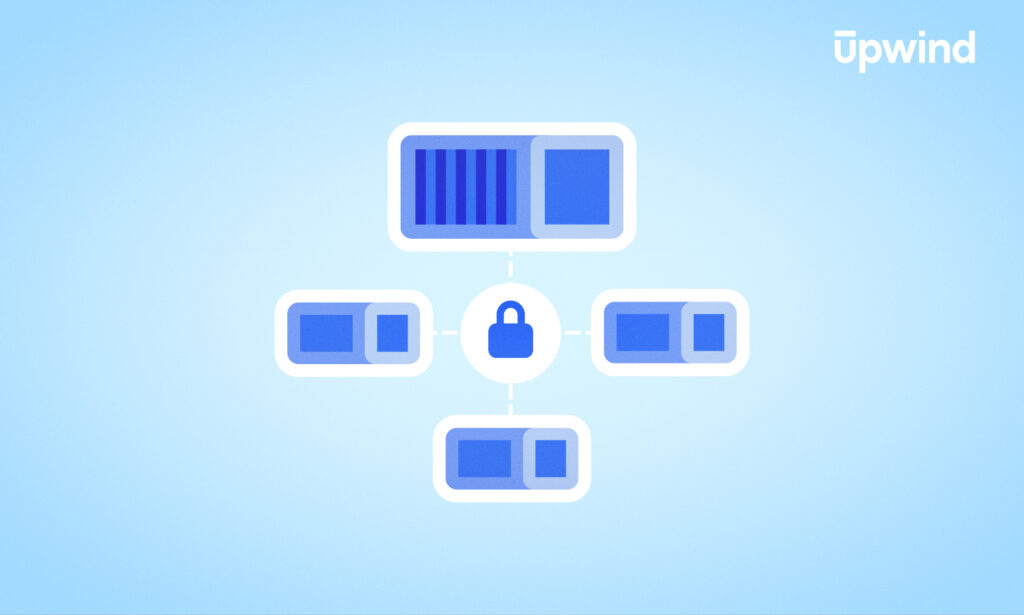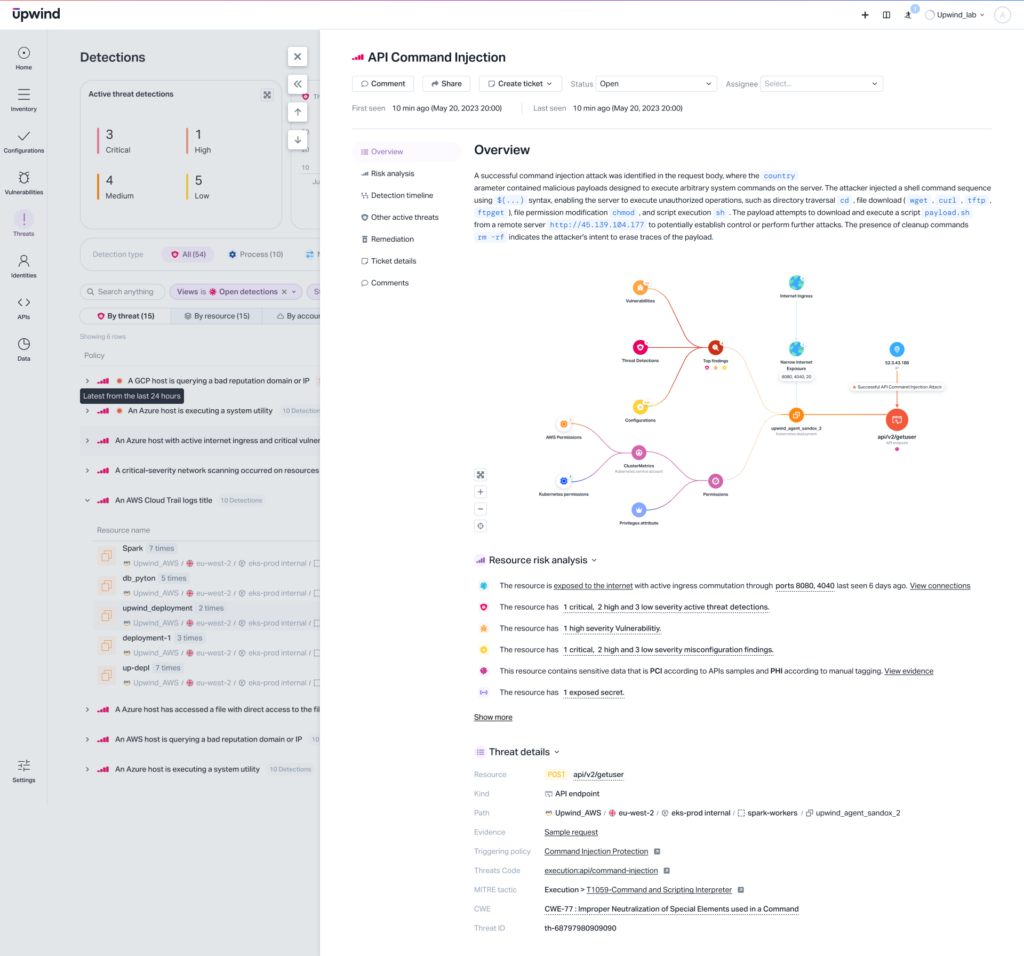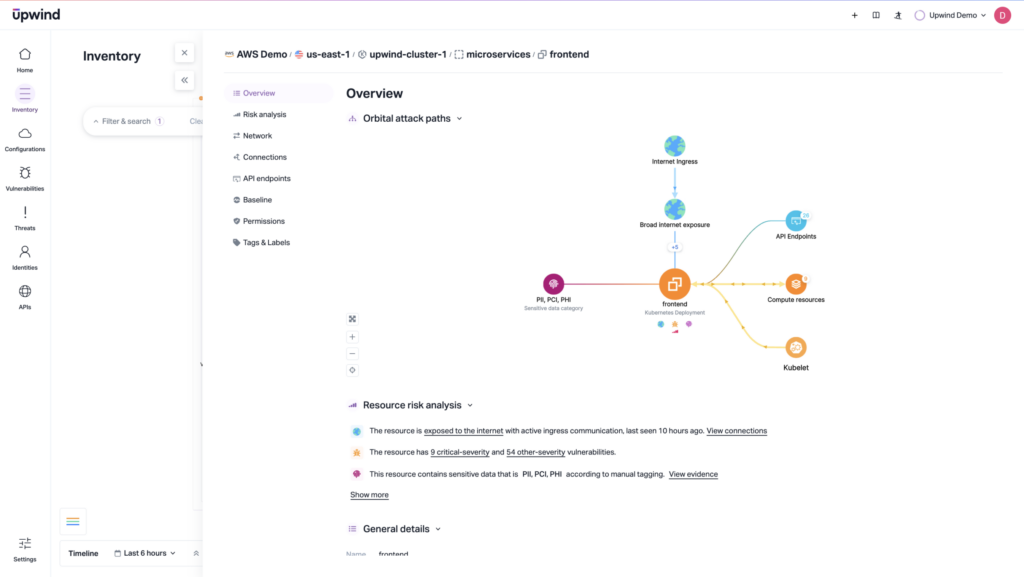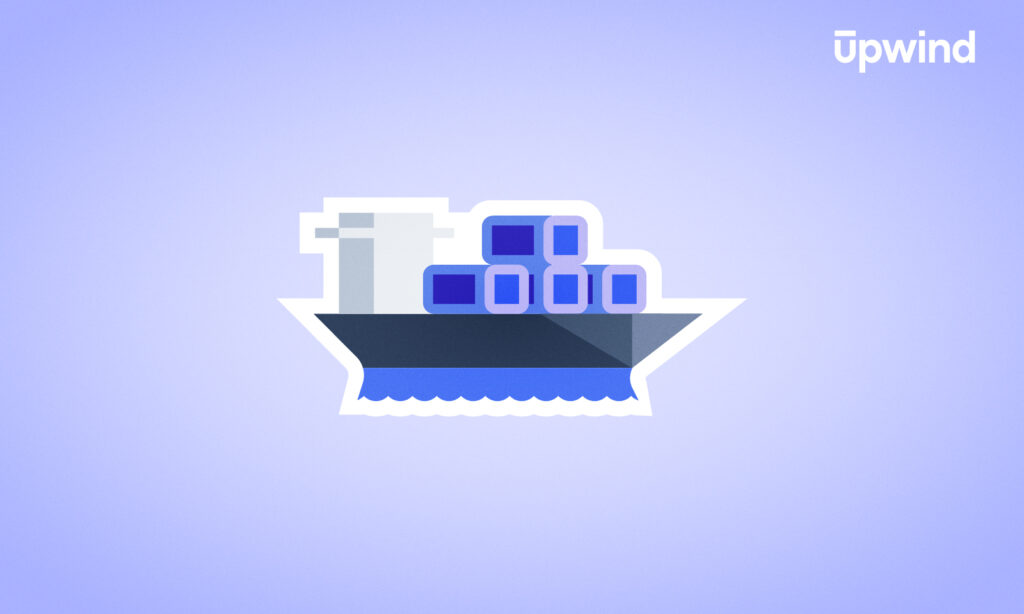
You’ve already asked, “Are we doing what regulators expect in terms of container security?” And you’ve considered, “Are our containers themselves secure?” But threats to apps running in cloud-native environments remain. And it can be easy to dwell on questions about runtime attack paths, breakout and blast radius, identity misuse, zero-trust implementation, and supply chain integrity. Are all these issues handled by securing the container infrastructure? Not exactly. Let’s go deeper into what it takes to truly realize application container security.
Refresher: What is Application Container Security in the Enterprise Context?
Application container security refers to protecting containerized applications across their entire lifecycle, from build to deployment and runtime, against vulnerabilities, misconfigurations, and active threats. In the enterprise context, that includes:
- Securing CI/CD pipelines
- Verifying image integrity
- Enforcing least-privilege access
- Monitoring runtime behavior
- Detecting identity and network-based attacks
It’s about more than scanning and hardening the platform and infrastructure, as with container security on its own. Application container security focuses on protecting what’s running inside containers, examining code, behaviors, and interactions.
Why can’t caring for containers themselves safeguard what runs inside?
The attack surface doesn’t stop at the platform layer, and the infrastructure is blind to what the app is actually doing. With app-layer threats that bypass infrastructure controls, teams need platform hardening, such as Role-Based Access Control (RBAC) or network policies. But they also need to identify issues like:
- A compromised app running malicious logic
- A legitimate container that calls an internal API it shouldn’t
- A service account abused inside the app to exfiltrate cloud data
Runtime and Container-Aware Security with Upwind
Upwind combines runtime-powered container scanning with application-layer behavior analysis so you don’t just detect known vulnerabilities, you catch what containers actually do in production. With real-time threat detection, identity-aware context, and fast root cause tracing, Upwind helps security teams respond to app-level risks up to 10X faster than traditional scanning tools.
The Case for App Layer Container Security
Most breaches today exploit application behavior, not infrastructure misconfigurations. Real-world breaches often involve:
- Infected dependencies, like Log4Shell-style issues
- Malicious insiders or exposed tokens
- Runtime behavior anomalies, like unexpected connections and shell spawns
One year after Log4Shell, a vulnerability discovered in 64% of Java applications, 50% of impacted organizations hadn’t yet updated to a fully patched version.
Vulnerabilities like these highlight the limitations of platform-level security. A container may pass compliance scans, run in a hardened Kubernetes environment, and still expose the business if its application behavior isn’t continuously monitored. The app layer is where workload identity meets real behavior, cloud permissions are used, secrets are exposed, and attackers dwell quietly, sometimes pivoting across services without tripping infrastructure controls.
Without visibility into the behavior of containerized applications, teams risk false confidence. The app layer is where risk manifests and where real-time detection must reside.
| Category | Platform-Level Security | App-Layer Container Security |
| What it Protects | Hosts, orchestrator, container runtime | App behavior, process activity, service-to-service trust |
| Common Controls | CIS Benchmarks, RBAC, network policies, and admission control | Runtime detection, syscall monitoring, identity misuse, behavioral anomaly detection |
| Tooling Examples | CSPM, policy-as-code, Kubernetes configs | eBPF sensors, Cloud-Native Application Protection Platform (CNAPP) with runtime visibility, SBOM and supply chain tools, policy enforcement tools, process sandboxing |
| Strengths | Enforces good hygiene and limits attack surface | Detects actual exploit activity, lateral movement, and post-deployment threats |
| Blind Spots | Can’t detect malicious code, data exfiltration, or runtime misuse | Doesn’t manage image drift, orchestrator config, or workload identity provisioning |
| Examples of Missed Threats | Infected but signed image, misused service account, logic bomb in code | Privileged host access, overly open ingress, exposed admin console |
| Best Used For | Compliance, posture management, and deployment enforcement | Real-time threat detection, blast radius reduction, and post-exploit monitoring |
Here’s a scenario where infrastructure hardening isn’t enough and app security for containerized workloads makes the difference: suppose an organization is running a Kubernetes-based web app in production, complete with hardened infrastructure, where:
- RBAC is enforced
- Network policies are in place
- Images are scanned and signed
- Admission controllers prevent unverified workloads
However, a developer unknowingly includes a popular JavaScript dependency that contains a hidden payload in a minor patch version. The image is scanned and signed, with no known CVEs detected at the time. When deployed, the compromised code executes a process that runs in the background, opening an external IP, making internal API calls, and scanning pods. Because none of those activities violate deployment policies or static configurations, platform tools see a healthy pod.

Meanwhile, eBPF sensors detect unexpected outbound traffic, a shell process spawned in a container that never spawns shells, and anomalous use of cloud credentials. These signals correlate across behavior, and the container is quarantined automatically. Alerts help escalate the issue to incident response teams, and forensic data is captured. Without runtime, no tools proved that the container wasn’t safe.

Application Container Security Architecture in Multi-Cloud Deployments
As with general container security, security controls don’t abstract cleanly across clouds. Each provider works with its own:
- IAM models, like AWS IAM roles or GCP service accounts
- Networking defaults, like VPC peering, firewall rules, and egress behavior
- Logging pipelines and detection capabilities
Ultimately, application-layer security, particularly in terms of runtime behavior, API access, and workload identity, needs to be decoupled from its platform to ensure consistency and enforceability.
It extends beyond centralized runtime monitoring. Here are the steps and tools to consider:
Decouple Security from Platform
Cloud-native security services, like AWS GuardDuty, offer protection within the AWS ecosystem, but not across clouds.
Utilize cloud-agnostic runtime sensors, such as those found in an eBPF CNAPP, deployed uniformly across all clusters. Then ensure that detection logic and policies are centrally managed, not duplicated across multiple clouds.
Get Consistent with Workload Identity and API Access Controls
Kubernetes workloads assume IAM permissions via cloud-specific mechanisms, like Workload Identity in GCP. These aren’t portable, and policies are inconsistent across platforms.
Abstract least-privilege policies at the container level, rather than just cloud IAM roles. Enforce identity-aware runtime behavior. And monitor API usage by workload, not static credentials.
Deploy Runtime Threat Detection Across Distributed Clusters
Containers in one cloud can communicate with workloads in another. Threats won’t respect cloud boundaries.
Deploy unified runtime detection that spans clusters and correlates behavior across clouds. Try DNS-aware network visibility instead of IP-based policies. And be sure to normalize and enrich logs centrally for forensic analysis and compliance traceability. Container tags can help aggregate and triage alerts.
Control Drift and Configuration Gaps in CI/CD
Containers built in one environment might be deployed to multiple clouds, which can introduce drift between build and deploy.
View Software Bill of Materials (SBOM) inventories, signed image verification, and license checks in the pre-deployment phase. After deployment, validate runtime configuration drift, checking network access along with image source and permissions. Pair admission controllers with runtime visibility to find containers that pass policy tests but later violate them.
Manage Federated Compliance and Evidence Collection
Teams need to detect threats but also follow compliance rules across clouds, where different rules reign. Get consistent enforcement and centralized logs for a single view of consistent policies.
Use a CNAPP or Security Information and Event Management (SIEM) integration to centralize event collection. Store evidence of enforcement decisions, exception handling, and runtime events tagged by the framework. Enable policy-based tagging at the workload level to automatically flag violations.
When it comes to containerized apps, the container workload itself serves as the security boundary. Protect it with instrumentation, monitoring, and prioritizing identity and behavior as priorities.
Lifecycle-Based Security Architecture for Containerized Apps
In addition to reckoning with multiple clouds, teams should look across the app lifecycle. Each stage (build, deploy, runtime, post-runtime) introduces unique risks — at build, libraries can introduce hidden payloads, for instance, while in deployment, container admission control policies are responsible for enforcing best practices.
However, teams also need to explore the trade-offs and secondary challenges they’ll face at every stage.
Build Phase
Security starts with defining what is allowed into containers, even before they’re in production.
Controls include CVE and license scanning of container images, SBOM generation, dependency version pinning, and static analysis tools in CI/CD. They’ll provide deep scans, but potentially slow production, and false positives might overwhelm dev teams.
What happens after instituting these safeguards? SBOMS may still become outdated quickly, with untracked changes rendering them less useful. And scans lack context, so they’ll tag vulnerabilities in components that never execute, leading to work without clear benefits.
Sign and Store Phase
Signed images and trusted registries ensure integrity and origin, but not behavior.
Use controls like digital image signing, trusted registry enforcement, registry access controls, audit logging. Signing proves source, but doesn’t guarantee safety, and devs may wind up bypassing signed registries for hotfixes or third-party images. Signature enforcement can be a challenge in multi-cloud ecosystems, too. Ultimately, inconsistent registry behavior can leave organizations open to policy drift, and they won’t even have runtime assurance.
Deploy Phase
Block known-bad misconfigured workloads before they run. Enforce least privilege, namespace restrictions, and image provenance. Enforce read-only file systems, no host networking, and no privilege escalation. And block deployments with invalid base images.
Complex policies can delay deployments, And overly strict rules with frequent exceptions make security, drift, and audits more challenging. In the end, policies only evaluate intent, not real behavior. It can be hard to keep them updated with the newest threat models, and they still won’t offer protection from logic bombs or hidden malware.
Runtime Phase
It’s all leading to runtime, where containers actually function, and not always according to what they were configured to do.
Use eBPF sensors to monitor syscalls, and couple this next-gen tech with anomaly detection and API call monitoring. But even high-fidelity detection may lead to alert fatigue, and true positives will require correlation across workloads. Real-time detection also risks not catching lateral movement unless paired with blocking logic. Teams will also find they need to tune behavioral baselines over time and add context, with workload tags and identity, to fully understand what’s happening in containers.
Post-Runtime/Forensics Phase
After a breach or policy violation, teams need traceability. Get centralized logging, forensic logging of processes and network flows, and immutable audit trails linked to workload identity. Even with the right approach, teams may find logs from ephemeral containers can be lost unless streamed, storage and compliance costs can soar, and cross-cloud audit normalization can be complicated.
In this phase, teams can discover that they need to coordinate multiple layers of defense to stitch together attack timelines. Further, detection gaps from earlier phases emerge to obscure incident clarity.
Yet, multilayer protection is key; teams who overengineer one layer of security won’t get the full picture across the software lifecycle. And for those that end security at deployment, it can be a harsh awakening when containers don’t behave as expected.
Lifecycle-based defenses are how teams prove what happened, but more importantly, how they prevent containers that behave problematically from spreading damage.
Upwind Safeguards Containerized Applications at Runtime
Upwind secures what containers actually do when it matters most — in real time. It continuously monitors application behavior across clouds and clusters, mapping workloads, identities, and API usage to detect threats that static tools miss. From catching runtime anomalies and identity misuse to preserving forensics for post-incident analysis, Upwind gives teams app-layer security that adapts to how containers work today: fast, ephemeral, and distributed.
Upwind helps teams connect the dots between infrastructure and application behavior, so they can stop assuming apps are safe and start knowing. Get a demo to see how Upwind was built with container security in mind.
FAQ
How does container security differ in multi-cloud vs. single-cloud environments?
In single-cloud environments, container security typically aligns with the native tools, configurations, and policies of that specific provider. The apps running in those containers take on the consistent policies of their platform defaults.
Multi-cloud environments, however, present a more complex landscape of diverse security tools, compliance requirements, and the risk of data movement between clouds. This requires solutions that can provide unified visibility, consistent policy enforcement, and interoperability across multiple cloud platforms — CNAPP or Cloud Workload Protection Platforms (CWPPs) are the primary tools designed to meet this need.
What are the most critical security controls for containerized applications?
Containerized apps need layered security controls that cover build, deploy, and runtime phases. The most critical controls detect real threats, enforce least privilege, and make sure there’s traceability across workloads. Use:
- Image scanning
- Admission control
- Least privilege enforcement
- Runtime monitoring
- Cloud API usage tracking
- Centralized logging
How can we strike a balance between security requirements and development velocity?
Balancing security with development speed involves choosing controls that are enforceable, automatable, and aligned with how people already work. It’s unrealistic to add security post-deployment and then expect teams to move fast.
- Shift left with CI-integrated scans that fail builds only on high-severity or exploitable CVEs
- Use policy-as-code tools to define clear guardrails
- Automate remediation for known misconfigurations, like auto-patching images
- Monitor in runtime to catch behavior that can’t be predicted during deployment
- Build exception workflows so devs can explain and track risk consciously
Abandon the zero-risk dream. Aim for controlled risk that developers can work within without creating bottlenecks.
How is Container Compliance Different from Container Security?
Compliance is about doing the right things. It’s based on frameworks such as NIST, PCI, and HIPAA, and relies heavily on traceability and audit trails to ensure adherence to security best practices.
Security is about stopping attacks. Compliance can contribute to good security, but it can’t always stop cybercrime. Compliance can be passed with weak controls, whereas security includes strict enforcement and visibility. It includes runtime behavior detection, anomaly response, identity misuse prevention, and blocking exploits.







